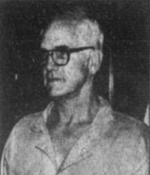 Photo by The Daily Oklahoman Around 2:00 a.m. on July 6, 1980, three men were shot and killed as they sat by a pool outside an Oklahoma City motel. A man who had been lingering around the pool concession stand area fired the shots and then immediately fled in a car. Police suspected the killings were orchestrated by Harold Dean Behrens, a former police detective who had turned to dealing drugs. One of the three victims, Ray Peters, worked selling drugs for Behrens and police viewed Peters as the primary victim. Behrens and Peters had recently had a dispute about, among other things, Behrens’s concerns that Peters would become a police informant following his recent arrest. Earlier in the night of the shooting, Behrens had been sitting poolside with the group. At this time, the group was in full view of the stranger standing by the concession stand. When Behrens stood up to leave, he put his hands on Peters’ shoulders as he said goodbye. The prosecution argued that this action was Behrens identifying Peters for the hit man who was lingering nearby. The shooting took place shortly after Behrens exited the area. In describing the shooter, the first eyewitness, Mary Chilton, a night office clerk at the motel, specified that he had a belly and salt and pepper hair, wore a baseball cap, did not wear glasses and that his skin was very pale in color. She observed him several times in the two-hour period that he was in the concession area. The other eyewitness was a motel guest, Carrie Pitchford, who had spent part of the day sitting with the victims and Behrens at the poolside table. After returning to her room, she looked out her window at the pool area and observed a large man with “very, very white” skin, a baseball cap with whitish hair sticking out and no glasses. When Detective Sergeant David McBride of the Oklahoma City police heard the description of the shooter, it brought to mind a man named Clifford Henry Bowen. McBride had formerly worked with Behrens when Behrens was a detective, and the two had been involved in a case where surveillance had been ordered on Clifford Henry Bowen due to his being a companion of an alleged criminal who was being watched by the police at that time. McBride speculated that perhaps Behrens had later hired Bowen as a hit man, based on this connection. A photo of Bowen was included in a photo lineup and the two witnesses, Chilton and Pitchford, identified Bowen as the shooter. Recalling the description of the shooter that had brought Bowen to mind, McBride explained “the salt and pepper hair. The big jaws, the pot belly. The horn-rimmed glasses. Several things that sounded exactly like him as I remembered him.” This recollection was noteworthy because both witnesses had specified that the shooter was not wearing glasses. The testimony of Chilton and Pitchford constituted the only evidence against Bowen – nothing else tied him to the crime. Additionally, Behrens continually asserted that he did not know Bowen. Even when Behrens was offered just a 10-year sentence for his own three murder charges in exchange for admitting that he knew Bowen, Behrens continued to insist he did not know him. Instead, Behrens received life without parole for his part in the killings. Bowen’s defense team provided twelve witnesses who could confirm that he was at a rodeo in Tyler, Texas – 300 miles from Oklahoma City – until midnight on July 5. One witness testified that he had called Bowen at his house in Tylerat 1:00 a.m. on July 6 – just one hour before the murders took place – and that Bowen had answered the phone. Additionally, Bowen offered testimony from several people who claimed he was suntanned on July 6, although his complexion was paler by the time he was arrested nearly two months later. Nonetheless, in March of 1981, Bowen was convicted on three counts of murder and sentenced to death. It was not until 1983, when Bowen’s appeal was pending, that he and his attorneys first learned of evidence, undisclosed by the prosecutor, implicating another possible shooter, Leonard Lee Crowe. Crowe was a police lieutenant from South Carolina who closely matched the physical description of the shooter provided by the two witnesses and, at the time of the shootings, he was living with Patsy Peters, the ex-wife of primary victim Ray Peters. In early July of 1980, Patsy Peters and Crowe were visiting Patsy’s family in Oklahoma, and they departed to head back to South Carolina on July 6. Later in 1983, a new witness, Deana Burris, the former roommate of Crowe and Patsy Peters, came forward to provide testimony that she had heard Crowe and Patsy plotting to kill Ray Peters in June 1980. In 1985, a binder belonging to the Oklahoma City police with documents dating back to 1980 was discovered as part of a federal hearing, and the binder contained substantial additional evidence suggesting that Crowe was the shooter. The suppression of this evidence was found to be a Brady violation, and, on January 22, 1986, Bowen’s convictions were set aside as constitutionally invalid. The decision not to re-prosecute Bowen was announced in July 1987. - Meghan Barrett Cousino
|